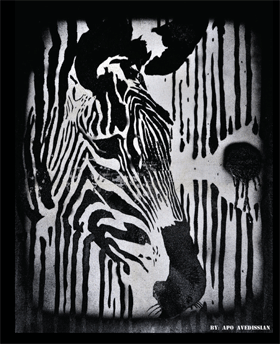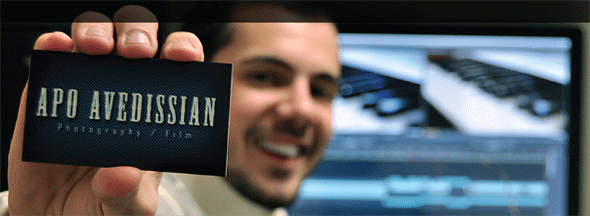Telling Unheard Stories
Our community is filled with hundreds of talented young artists pushing the boundaries of expression and creativity in various fields. Haytoug recently had the chance to sit down with one such prominent young artist: filmmaker, photographer, and writer Apo Avedissian.
Haytoug: Can you give us some background on how you got involved in photography, videography and art in general?
 Apo Avedissian: During the 2003 war in Iraq, I was a 13-year-old kid in Baghdad with a camera, walking around taking pictures of arms and legs detached from bodies. I found a subject to tell a story about: the war. Photography wasn’t my hobby, storytelling was. That’s why I’ve not only done photography, but also filmmaking, stenciling, and writing. Art is my tool of choice. High school in the U.S. also gave me a major push towards getting into the business aspect of art itself. I was invited to Hoover High School’s Art Academy during the first two months of a photography class and was soon given two awards that allowed me to buy a new, professional camera. It was my first professional camera.
Apo Avedissian: During the 2003 war in Iraq, I was a 13-year-old kid in Baghdad with a camera, walking around taking pictures of arms and legs detached from bodies. I found a subject to tell a story about: the war. Photography wasn’t my hobby, storytelling was. That’s why I’ve not only done photography, but also filmmaking, stenciling, and writing. Art is my tool of choice. High school in the U.S. also gave me a major push towards getting into the business aspect of art itself. I was invited to Hoover High School’s Art Academy during the first two months of a photography class and was soon given two awards that allowed me to buy a new, professional camera. It was my first professional camera.
H: Is your foundation based on formal training from those classes or did you develop your talent outside of the school setting?
A.A.: I do tend to be an egomaniac, so I will say everything is based on myself. Although I am influenced by things around me, just like anyone else, once I took those classes I really wasn’t a fan of being told how to make art. In math, when one person discovers a new formula, they’re praised as scientists, and they should be. In art, however, there’s that one fine line you need to follow. I don’t like that. Art is self expression to me, and the fact that a class exists to teach you how to be creative is just a bit too much. The fact that there are classes shows other people’s opinions, however, so as long as I’m not forced to join an art class, anyone is free into joining one and experimenting with anything they’d like.
H: A lot of people know you for directing and producing music videos. What is it about the intersection of music and video that you enjoy?
A.A.: Storytelling. I don’t talk a lot in person. I tend to observe and create art in my mind. Art is how I express myself. If I feel a certain way about an event or anything around me, I will tell the story through art.
H: What are some of the key projects you’ve worked on, and the achievements you’ve had so far?
A.A.: My ability to reach out and have thousands of people being a click away from viewing my work online is what I consider my main major achievement. With the $100 cheap camera that I started with, I built a 35,000 people fan base on MySpace when I first started. Now I’m on Twitter, which was also a tool I used for a really cool Armenian project.
I love being criticized. I live for the feedback. Feedback and criticism are more important, to me, than medals and trophies.
H: For many people, finding motivation to be creative and developing original concepts is not easy. Where do you find your inspiration/influence?
A.A.: I wake up with it. Not in the same bed though [laughs]. All jokes aside, I do have rituals and certain things I do and go through daily to have a good artistic day. Another artist once said “you’re crazy,” when they saw what I go through daily, to which I replied “I’m making art every day. What are you doing?”
H: How do you think being Armenian and from a family that has survived Genocide and war has affected your art?
A.A.: With what my grand-grandparents went through during the Armenian Genocide, you can only think of the negatives. After going through and surviving the Genocide itself, they settled in Baghdad, Iraq. Soon enough that country was another bleeding place for everyone in it.
I left Iraq late 2004, about two years into the war. What I saw made me who I am, so I can only use my imagination to try and see what my grand-grandparents went through back around 1915. The first half of my life was based on the Genocide stories, and the quarter that followed it is based on the war I, myself, went through and survived, as well.
The Armenian Community in Iraq did a really good job teaching us our culture, language, and everything they could keep alive from the past. So good, in fact, that I still remember and know most of my elementary school lessons about Armenians. Because of all of that, my work shows more tears than smiles, I realize.
H: In addition to your work with the camera, you’ve become known for your incisive blog entries and writings on Apotize.com. What are your thoughts on the power of conveying ideas through mediums such as writing as opposed to words or visuals?
A.A.: Writing and visuals are the tools I use to tell what I have in mind. Whatever fits the topic, I will use. Sometimes a picture does it all. At other times, that picture isn’t clear enough, not as clear as a blog. I like to influence people. I don’t like forcing anyone into doing anything. I want to influence, yet again, giving them the full option of choosing what they do next. Just like a reminder, I’ll bring up some facts from both sides without forcing a decision. You are reminded; you choose to snooze or wake up.
Writing is a very powerful tool to put out emotions and ideas. Last year, on April 24th, I wrote a blog on Apotize.com asking everyone to use Twitter to post or “tweet” a fact about the Armenian Genocide, and add the hashtag #ArmenianGenocide in the tweet itself. By doing that, we might be able to “trend” that phrase, which means millions of visitors on the site, whether Armenian or not, could see the phrase as ‘most used/ popular’ for that day and time. Later that day, we had “#ArmenianGenocide” and “Armenians” trending in Los Angeles. That was a huge success on our end, and with the help of the readers we were actually able to do something very productive, and answered many “odars’” questions about the trend, which they had no idea about.
On that day, we taught thousands of people about the Armenian Genocide, all with one simple idea that came to my mind, and through my writing, got many great minds involved. This year, I intend to try it again, hopefully trending the phrase #ArmenianGenocide worldwide, having everyone logging in to Twitter see it, and once they click on it, see the facts we’re posting and our unheard stories.
H: What role do you think artists play in society, specifically for the Armenian community in the Diaspora?
A.A.: Teachers. Artists show you things you haven’t seen before or have forgotten about. Artists put your attention on an important topic to them, and you choose whether to understand it or not. Artists can be teachers, inventors, and even historians, to be honest. When you have a 100 year old art piece, that is good enough, you will look at the picture and remember stories about that time.
H: What are some upcoming projects we can expect from you?
A.A.: I’m in the process of stenciling a 17×7 ft. wall for a music video I will be featured in. I’m also working on a documentary titled Yergat. The rest is your imagination.
I don’t plan things, they just happen. I know about those two because the documentary I’ve been working on for about five years now, and the stencil I planned two days ago. I’ll soon stencil and shoot the video for it.
H: How do people get in touch with you regarding commissioning work?
A.A.: My personal website (www.apomontage. com) has my email, Twitter, and Facebook links beside my work.



Leave a Reply
Want to join the discussion?Feel free to contribute!